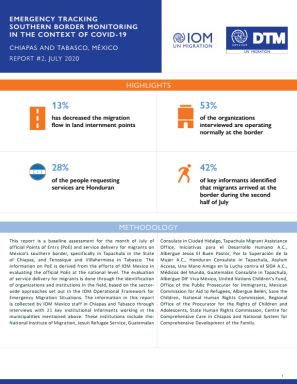-
Countries
-
Data and Analysis
-
Special Focus
-
Crisis Responses
Mexico-Emergency Tracking, Southern border monitoring in the context of COVID-19, Round #2, JULY 2020

Contact
Laura Canché, lcanche@iom.int
Language
English
Location
Mexico
Period Covered
Jul 01 2020
Jul 31 2020
Activity
- Mobility Tracking
- Points of Entry (PoE)
- Event Tracking
On 11 March 2020, due to the alarming levels of spread and severity of the COVID-19 virus, the World Health Organization declared a state of pandemic. In this situation, on 23 March 2020 the General Health Council of the Ministry of Interior of the United Mexican States recognized the epidemic as a serious disease of priority in the national territory.
The federal government applied the "Sana Distancia" campaign from 23 March to 31 May, promoting isolation at home, applying basic measures to prevent contagion, and instructing the closure of non-essential establishments for emergency health care, including businesses, schools, and institutions at all three levels of government. In the case of the governments of Chiapas and Tabasco, they also began the “Sana Distancia” campaign in parallel with the federal government, applying the same recommendations on the suspension of activities, including procedures, applications and legal proceedings. On 1 June, the campaign “El Semáforo de Riesgo Epidemiológico” (Epidemiological Risk Traffic Light) launched as a weekly monitoring system to monitor and grade the use of public space according to the risk of COVID-19 transmission.
During the month of July, the Epidemiological Risk Traffic Light categorized most of Mexico as red (highest risk) and continued to call for the restriction of non-essential economic activities. The state of Tabasco remained in this category with 22,994 accumulated cases and 2,094 deaths as of 31st July and remained as one of the states with the greatest hospital occupation. The municipality of Centro, where the city of Villahermosa is located, is where most of the cases in the state have occurred with 10,546 accumulated cases and 872 deaths, while Tenosique reported 711 cases and 48 deaths.
Likewise, some states went to the intermediate warning light (orange), which allowed the reactivation of some economic activities. Such is the case in Chiapas, which acquired this category in the second half of July. Chiapas reported 983 deaths and 5,836 accumulated cases as of July 31, of which 911 cases and 172 deaths were in the municipality of Tapachula.
The Mexican government has registered 310 positive cases of migrants at the national level in July, mainly from Honduras, the United States of America, Bolivarian Republic of Venezuela, Cuba, El Salvador, and Guatemala, among others. Fourteen deaths of migrants from El Salvador, Guatemala, Honduras, Haiti, Canada, Chile, Cuba, Spain and the United States of America were reported. In the southeast, eight positive cases were recorded among the migrant population, of which four occurred in Tabasco, two in Chiapas and two in Oaxaca.
This report constitutes a baseline evaluation for the month of July in order to know the status of the official Points of Entry (PoE) and the provision of services for migrants on the southern border of Mexico, specifically in Tapachula in the state of Chiapas and Tenosique and Villahermosa in Tabasco under the context of COVID-19. The information on points of entry is derived from the efforts of the IOM Mexico mission in evaluating official PoE's at the national level. The assessment of service delivery for migrants is done through the identification of organizations and institutions in the field, based on the sector-wide approaches established in the IOM Operational Framework for Emergency Situations of Migration Crises.
